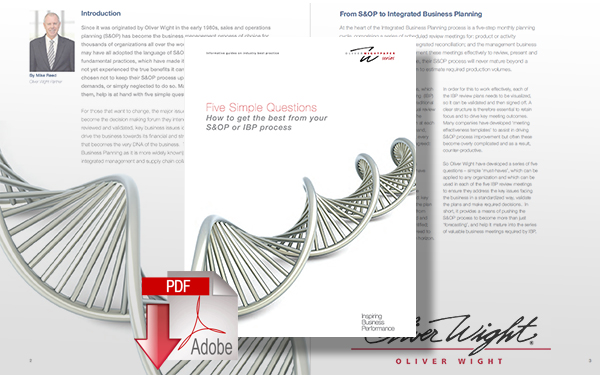Minimizing Chaos with Demand Control and Execution Plans as an Integrated Business Planning Model

Establishing how demand execution is fully integrated with demand planning and integrated business planning will go a long way in reducing chaos.
Why Near-Term Demand Execution Is Needed
It is probably safe to say we all have lived through a bit of chaos at times, where we feel things are out of control and fires are popping up everywhere.
This can apply to a number of areas.
If we think about how this applies to Demand Execution, we see executives getting involved in the details.
Monthly Executive Reviews that are intended to be long-term views of the business can’t seem to address anything but the current month or the current quarter.
We made the wrong product because plans keep changing with the resulting impact on working capital at the end of the year from Excess and Obsolete inventory.
The list goes on and on. I’m sure we can all see symptoms that resonate.
Integrating Execution with the Plan
There is an interesting book called Execution – The Discipline of Getting Things Done, by Larry Bossidy, Ram Charan.
Demand Execution is doing what it takes to make demand happen.
This encompasses prioritizing demand, understanding orders, updating the near-term demand, and continuous improvement.
I have been involved in the design and implementation of this process as part of enterprise-wide transformations to define the roles, accountability, agenda, etc.
Demand Control fits into the larger context of an Integrated Business Planning Model that integrates monthly, weekly, and daily activities over the various time horizons and time fences.
The bottom line is we must manage the change.
Clear Roles and Accountability to Drive Decision Making and Action
In order to manage change, we must monitor what’s going on and decide who gets to make the decision when things change and how to get things done.
Daily and weekly processes ensure that actual demand is proactively managed in line with market segment plans and that the business can respond to the requested demand plan.
The Demand Execution Manager is the facilitator of the process, ensuring Sales participation and prioritization in decision making, and appropriate feedback into longer-term demand planning.
Once we understand roles, responsibilities, and accountabilities – lines of communication are open and clear.
The 10 Keys to Demand Execution are:
- Time fences have been established and are respected
- Available to promise is used for order promising
- Abnormal demand is identified and managed
- Formalized ongoing demand monitoring is in place
- Formal processes and rules are established for forecast consumption and roll
- Change inside the planning time fence is formally managed
- Demand execution is fully integrated with demand planning
- Weekly, daily cadence is in place
- Roles and responsibilities have been defined
- ERP system capability has been exploited
Establishing a Demand Execution process with a particular focus on establishing time fences to know when and who should be making changes, the roles and responsibility of key players in a weekly and daily cadence, and how Demand Execution is fully integrated with demand planning and Integrated Business Planning will go a long way in reducing chaos.
On-Demand Webinar Minimizing Chaos With Demand Control and Execution
About the Author
Pamelyn Lindsey, an Oliver Wight principal, is a consultant and educator providing organizations with guidance on the design and implementation of effective and sustainable business processes. Pam has over 28 years of specialized industry experience in Integrated Business Planning implementations, Demand Planning, Financial Integration, Scenario Planning, and the Oliver Wight IBP Accelerator software tool. She has a proven track record in Supply Chain process improvement, hands-on implementation, and delivery of related coaching, training, and education for senior management as well as multi-level teams with a solution-oriented approach.
Related Article Integrated Scenario Planning As an Agile Framework to Develop Responses to Coronavirus
Related Resource
How to Get the Best from Your S&OP or IBP Process
In this white paper, we discuss a series of five questions - simple 'must-haves', which can be applied to any organization and which can be used in each of the five IBP review meetings to ensure they address the key issues facing the business in a standardized way, validate the plans and make required decisions. Download Now!
More Resources from Oliver Wight
Webinar | Do-It-Yourself Integrated Business Planning: How to Save a Failing Process
Webcast | How Good is your Sales and Operations Planning Process?
Education | Integrated Business Planning (Advanced S&OP) Course
Article Topics
Oliver Wight News & Resources
Talking Supply Chain: Why IBP is the Future of Procurement Never Ask “Who Owns The Inventory?” Again - It’s The Wrong Question to Ask How to Change Your Supply Chain Inventory Planning Process Who Owns Inventory? Education as a Strategic Advantage Making the Case: The ROI of Demand Management Will Your Demand Management Plan Pay Off? More Oliver WightLatest in Supply Chain
Trucking Industry Pushes Back on Government’s Electric Mandates Senators Take Aim at Amazon with Warehouse Worker Protection Act Maersk Sees Silver Lining in Red Sea Shipping Challenges Happy Returns Partners With Shein and Forever 21 to Simplify Returns Baltimore Opens 45-Foot Deep Channel Following Bridge Collapse El Paso Border Delays Cost Juarez $32 Million Per Day in Economic Losses Ranking the World’s 10 Biggest Supply Chains More Supply Chain
















